projects
Broadway-Manchester Multi-Modal Green Street Project Feasibility Study
SEITec was contracted by the City of Los Angeles, Bureau of Street Services (StreetsLA) and completed a comprehensive feasibility study for the Broadway-Manchester Multi-Modal Green Street Project. The project, which lies along a 2.8-mile corridor of Manchester Ave and Broadway located in the heavy disadvantaged South Los Angeles area, is the evolution of the Broadway-Manchester Active Transportation Project realized by the addition of stormwater elements.
The study was performed in accordance with the Los Angeles County Safe Clean Water (SCW) Program for funding under the Regional Program. The purpose of the Project is to accomplish stormwater quality compliance, provide water supply benefits, and realize community investment and environmental sustainability benefits consistent with the goals of the SCW Program. Work included development and evaluation of Stormwater Best Management Practices (BMPs) that include nature-based solutions, hydrology and hydraulic modeling to size the selected BMPs, long term hydrological and water quality modeling and simulation to determine the project water quality and water supply benefits, evaluation and determination of community investment benefits, and scoring the project based on the SCW Program criteria.
The primary objectives of the project are: 1) meet the water quality (TMDL) limits for the Upper Los Angeles River watershed and current NPDES permit by capturing the 85th percentile storm compliance volume, 2) maximize the project social and environmental water supply benefits for the local community by utilizing the captured stormwater for project landscape irrigation, 3) maximize the project sustainability by deploying Natural Systems for water treatment, 5) enhance the environmental, public health and community benefits by creating green infrastructure, and 5) maximize the project economic, educational and community investment benefits.
The secondary project objectives are: 1) support and enhance the active transportation opportunities along the Broadway-Manchester corridor, 2) implement sustainable greening protocol for O&M, biodiversity, resilience/disaster relief, and public health benefits through nature based landscaping solutions, 3) build collaborative regional educational opportunities that stimulate career interests, and awareness, and 4) provide insightful and replicable green infrastructure plans.
Project information
Location: Los Angeles, California Client: City of Los Angeles, Bureau of Street Services, Status: Completed July 2020
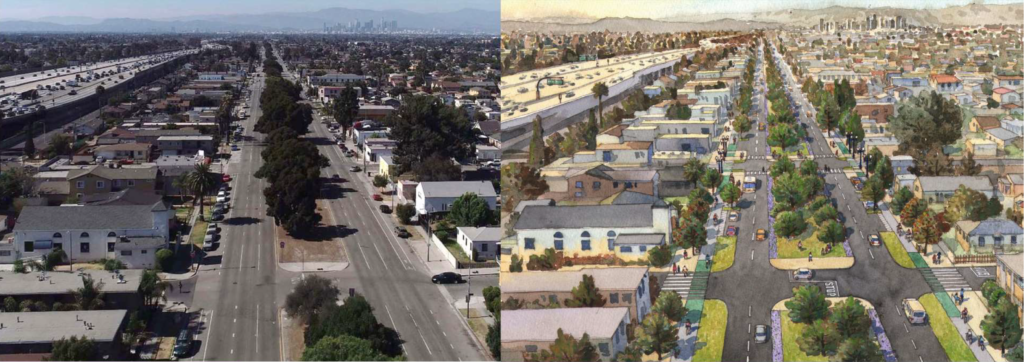
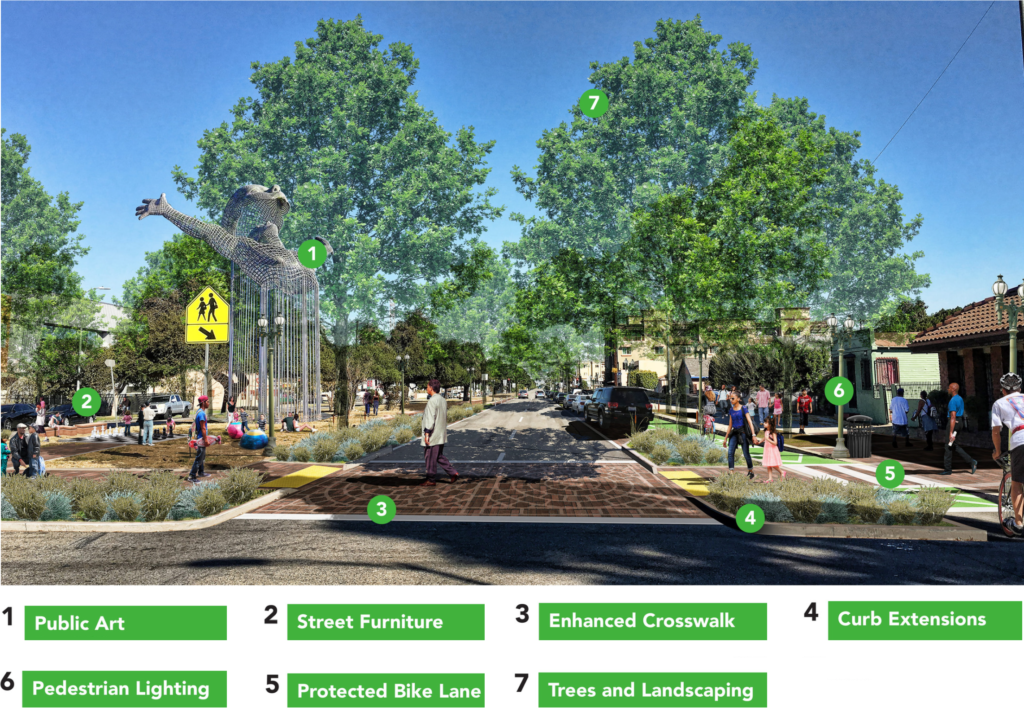
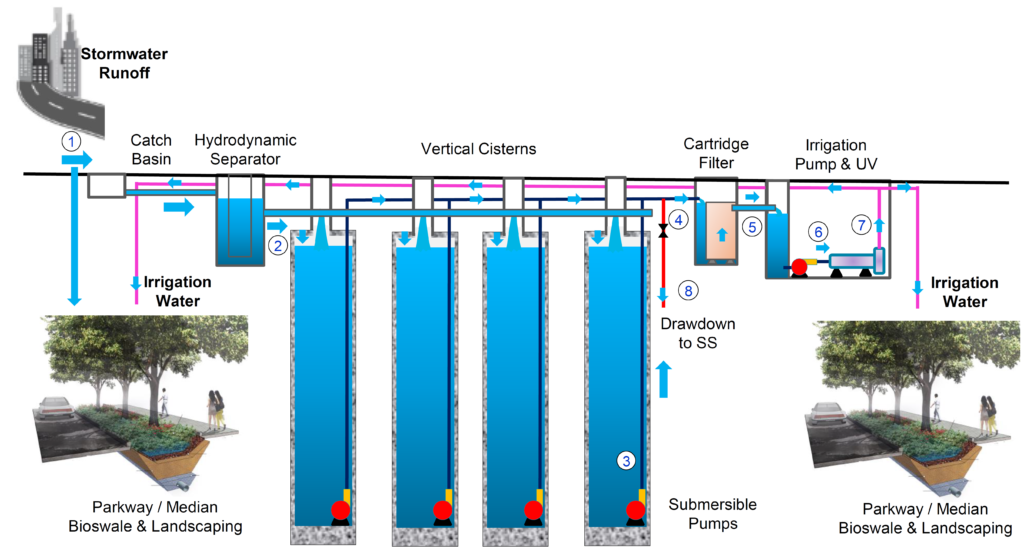
Project Scheme
MacArthur Park Stormwater Project Feasibility Study
SEITec served as the main sub-consultant responsible for developing concepts, performing modeling, and writing the report for the MacArthur Park Project Feasibility study submitted by the City of Los Angeles for funding under the County Measure W "Safe, Clean Water" Program. The objectives of the MacArthur Park stormwater project are to accomplish regulatory NPDES compliance for the Ballona creek watershed, enhance lake water quality, offset potable water use using captured stormwater, and provide tangible community investment benefits.
The project uses innovative vertical cisterns (WaterSilo) installed in the public right of way that serve as both raw stormwater storage, as wells as pump station that receives diverted stormwater and discharges to a high-rate media filtration + UV treatment facility for subsequent storage of the treated stormwater in the lake during the storm event.
The project also installs natural bioswale and infiltration meadows to capture and treat the runoff, and redirects the treated runoff to the lake for further treatment by constructed wetlands and for storage.
All stormwater captured and stored by the project is treated and used either directly for irrigation, or to replenish the lake for water pumped for irrigation use by Phase I project, and to make up for direct lake evaporation loss. The natural bioswales and infiltration meadows sized for wet-weather treatment of Onsite watershed areas, and are used as a treatment stream for the stored raw stormwater during dry weather. The high rate treatment facility is sized for wet-weather treatment of the Offsite area. Both treatment streams discharge their treated effluent to the lake, while the effluent from the high-rate treatment facility could also be pumped directly for park irrigation.
Drawdown of the project retention volume is accomplished by pumping to the sanitary sewer, which convey the water to the Hyperion Water Reclamation plant where it is stored for recycled water production.
The Project also installes floating islands or “Chinampas” that improve lake water quality as they offer opportunities for recreation, culture and innovation. Also included are constructed wetlands for natural treatment and lake water quality improvement
Project information
Location: Los Angeles, California, Client: City of Los Angeles, Bureau of Sanitation, Status: Completed
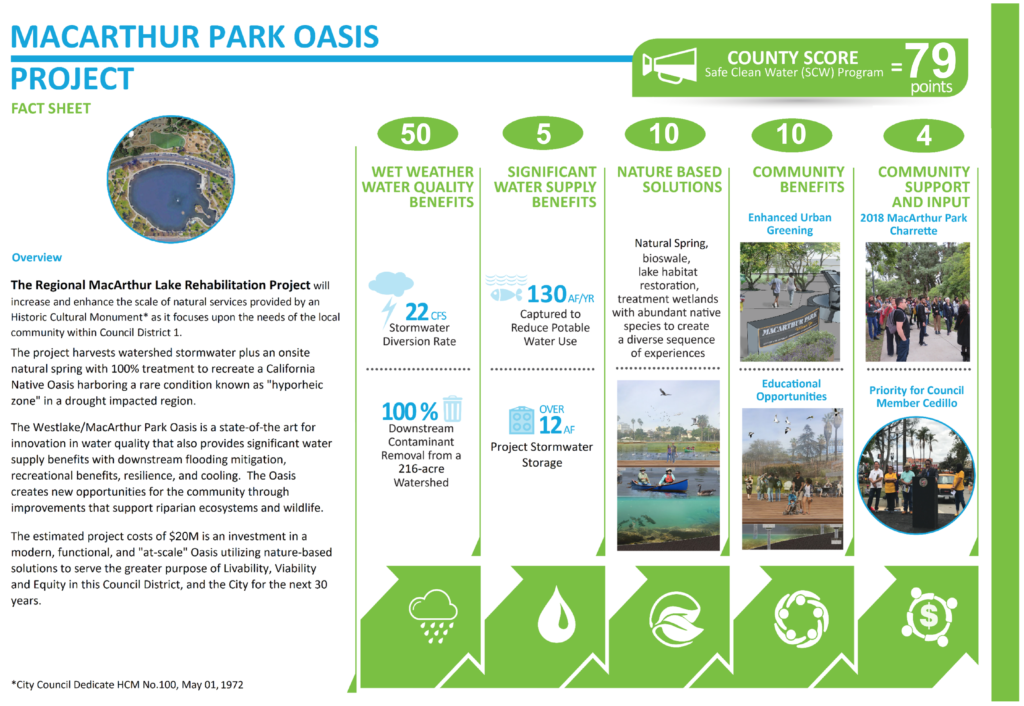
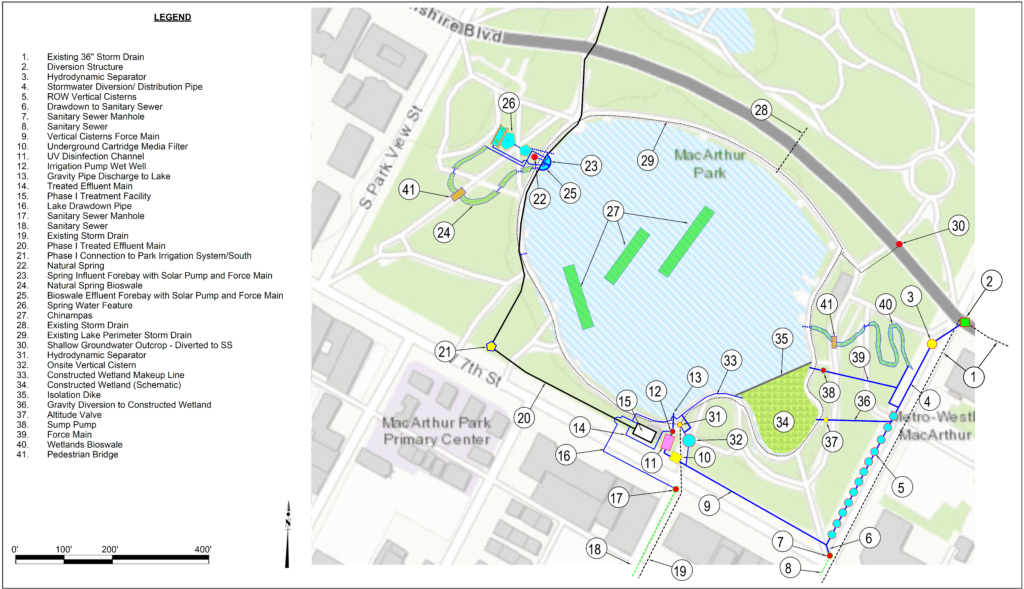
MacArthur Park Freshwater-Use Reduction and Offset Study
SEITec is collaborated with the City of LA, Bureau of Sanitation on various water conservation and re-use projects. MacArthur park is a major freshwater user targeted for reduction. The work on this project included a Phase I concept and feasibility study to reduce or prevent freshwater loss from the lake, capture and recirculate the freshwater loss, capture, treat, and beneficially use dry weather flow and stormwater runoff in adjacent storm drains, and prepare budgetary cost and schedule estimation for the preferred scheme. This study determined that the 2.8 MG/Y of freshwater could be saved by irrigating the park from treated lake water rather than freshwater. This project consists of retrofitting of the existing pump house to accommodate the new irrigation pump and treatment system, connection to the existing irrigation mainline, and installation and testing of control systems.
Project information
Location: Los Angeles, California, Client: City of Los Angeles, Bureau of Sanitation, Status: Completed

MacArthur Park Lake Water Treatment and Irrigation System Reconfiguration
SEITec developed, designed, and supervised the construction of the City of Los Angeles first alternate water UV treatments system for direct surface irrigation for MacArthur Park. The City of Los Angeles and California are focused on water conservation and reuse to offset freshwater use and reduce the use of imported water. The MacArthur Park Lake Water Treatment and Irrigation System Reconfiguration project is a signature model project for the City of Los Angeles stormwater capture and use project. The project installs a rapid sand filtration plus UV disinfection system to treat the lake and use it for park irrigation via the existing spray system. The conversion uses the lake overflow water, which is needed to maintain salt balance in the lake and is currently discharged to the storm drain, for irrigation. This will reduce the average freshwater use of the park by about 2.4 Million Gallons (MG) per Year, which is about 11% of the estimated average annual total freshwater consumption of 24.6 MG per year in the park. The project will also improve the lake water quality and reduce salinity by increasing the average annual water discharge from the lake from the current 2.4 MG for salt balance to 14.3 MG for irrigation. The project has been operating since July 2018.
Project information
Location: Los Angeles, California, Client: City of Los Angeles, Bureau of Sanitation, Status: Ongoing
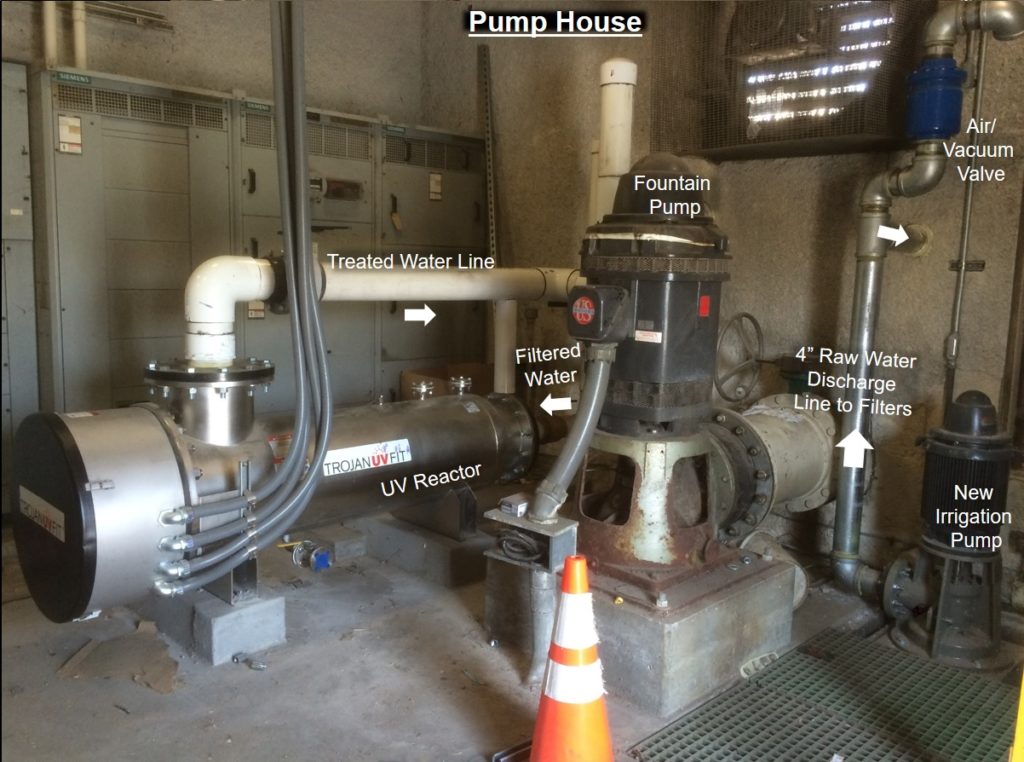
110-Gaffey Park WaterSilo Project
SEITec designed, fabricated, and installed the City of Los Angeles first "WaterSilo", a SEITec Engineered Solution comprised of a vertical storage tank for urban stormwater storage installed by large diameter auger drilling .
WaterSilo is a vertical, large-diameter, underground vessel (silo) for stormwater Storage (Cistern) and Detention-Infiltration (Drywell). It has a small footprint that fits in the public right of way, and can therefore serve as storage/detention in "Green Streets". WaterSilos can interconnect and cluster in flexible arrangements to provide the required storage. Multiple WaterSilo clusters can be installed under roads in urban watersheds to capture runoff from various size basins and create self-sustaining Green Streets throughout.
WaterSilo incorporates a Fiber Reinforced Polymer (FRP) Tank for storage, or an Open Shell with a drywell for detention-infiltration. Standard WaterSilo FRP tanks and shells are available in capacities of 750 to 30,000 gallons, with diameters of 6 to 12 feet, and heights of 6 to 40 feet.
Larger WaterSilos of up to 30 feet diameter and 100,000 gallon capacity are available using cast-in-place concrete with temporary Corrugated Metal Panels as formwork.
Project information
Location: Los Angeles, California, Client: City of Los Angeles, Bureau of Sanitation, Status: Completed
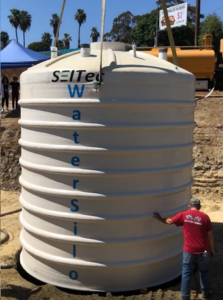
City of Rolling Hills, CA MS4 Compliance - Feasibility Study for Bent Springs Canyon/City Hall Measure W Project
The City of Rolling Hills is subject to MS4 discharge permit and wishes to accomplish full compliance with its mandated requirements. In particular, the City is looking into capturing the 85th percentile storm runoff flows that exit the City boundary at creeks and canyons. For funding, the City wishes to take advantage of the grant opportunity available through the County of Los Angeles Measure W Safe Clean Water (SCW) program. The program requires completion of a feasibility study for individual projects as part of the application process.
SEITec was contracted by the City of Rolling Hills to prepare the feasibility study report for the Bent Springs Canyon/City Hall Project, as well as prepare and submit the grant application to the County SCW program for funding in fiscal year 21-22.
Project information
Location: Rolling Hills, California, Client: City of Rolling Hills, Status: Completed
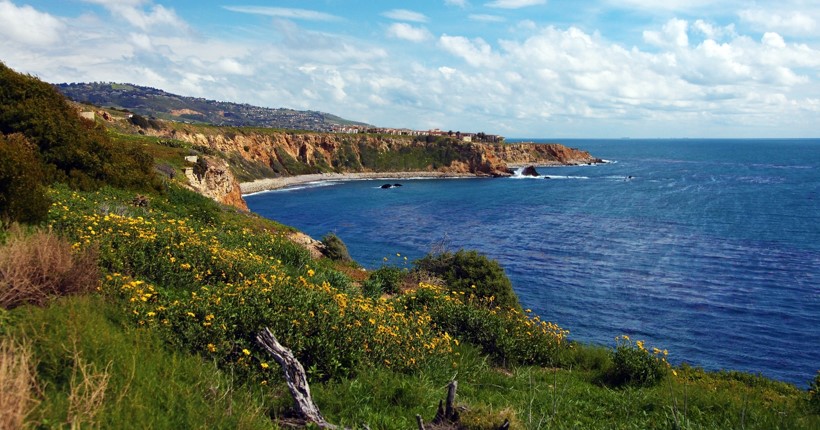
City of Rolling Hills
Los Angeles River Water Storage Potential - Special Study Under One Water LA
The One Water LA 2040 Plan (One Water LA) is a comprehensive planning process to increase sustainable water management for the City of Los Angeles. As part of the study team that assists with the preparation of the One Water LA 2040 Plan, SEITec developed conceptual water management alternatives to enhance water supply by leveraging the existing infrastructure provided by the Los Angeles River channel. Work includes analyzing the storage potential in the LA river through in-channel impoundment structures such as inflatable rubber dams or other on or off-channel systems, diversion of flows to D.C. Tillman Water Reclamation Plant, Treatment and/or recycling of the stored water for quality improvement, and distribution of retained water for either groundwater recharge or potable water offset (e.g. irrigation).
Project information
Location: Los Angeles, California, Client: City of Los Angeles, Bureau of Sanitation, Status: Completed

Feasibility of Recycled Water Supply and Stormwater Harvesting at Lopez Canyon Landfill
City of Los Angeles Bureau of Sanitation (LASAN) owns and operates the Lopez Canyon Landfill Facility, which utilizes potable water for all its needs and is on the list of facilities with large water use. LASAN is interested in evaluating alternative water sources to offset or supplement potable water use. The purpose of this study is to evaluate the feasibility of utilizing recycled water and/or stormwater as alternative sources of water supply to offset or supplement the existing potable water use at the Lopez Canyon Landfill Facility. To support the evaluation, we developed practical concepts for 1) the extension of Reclaimed Water Supply from existing purple pipes to the Facility using a pipe-within-a-pipe system called CoPipe (www.co-pipe.com) that consists of collapsible pipes in existing storm drains, where feasible and beneficial, and 2) the on-site capture, conveyance, and storage of stormwater for use at the landfill.
Project information
Location: Los Angeles, California, Client: City of Los Angeles, Bureau of Sanitation, Status: Completed

Identification of Climate Change Adaptation Projects
Los Angeles Sanitation (LASAN) owns and operates critical wastewater, stormwater, and solid waste infrastructure (assets) that must remain operational at all times. LASAN's recent vulnerability analysis found the need for increasing the resiliency of several facilities for climate change to accommodate temperature rise, increased risk of flooding, sea level rise and storm surge, increased risk and severity of wild fires, draught, and high winds. SEITec conducted a study to identify and evaluate climate change adaptation projects for 12 LASAN facilities to be included in LASAN's 10-year Capital Improvement Program.
Project information
Location: Los Angeles, California, Client: City of Los Angeles, Bureau of Sanitation, Status: Completed

Silver Lake Water Conveyance and Supply Study
This ongoing project is for a rapidly implementable scheme to empty the water in Silver Lake by conveying it to the LA Glendale Water Reclamation facility for treatment, and provide the means of filling the lake with non-potable water and sustainable future supply for its water needs. SEITec is providing a novel solution that uses the existing stormwater drains for both emptying and filling of the lake by developing an innovative pipe within a pipe system called CoPipe (www.co-pipe.com). This work also involved the study of the potential of Silver Lake as a reservoir for harvesting stormwater. SEITec developed a stromwater capture system that can capture storm runoff from the local watershed and supply 80% of the lake's annual water demand of about 100 MG.
Project information
Location: Los Angeles, California, Client: City of Los Angeles, Bureau of Sanitation, Status: Completed

Ballona Creek Diversion and Treatment Project Review
Project included technical review of the draft PDR for the Ballona Creek Water Quality Improvement project that involved low flow diversion and treatment. The Draft PDR consisted of a diversion rubber dam across Ballona Creek, a pump station, cloth filtration, sedimentation, chlorination, and return to Ballona Creek. The technical review identified potentials for simplifying this design and resulted in optimization of the diversion scheme and replacement of the chemical treatment by UV.
Project information
Location: Los Angeles, California Client: City of Los Angeles, Bureau of Sanitation Status: Completed

Los Angeles River Water Storage Potential Study
The purpose of this work was to examine the potential of LA River as a massive reservoir for storage of large volumes of dry weather flow and stormwater runoff using inflatable rubber dams. The work included hydrology/hydraulic analysis of the lower 21.0 miles of the Los Angeles River, identification of 19 suitable sites for inflatable dams, and water balance analysis to determine the water storage and yield potential. The study identified the tremendous additional value of the iconic Los Angeles River for water sustainability and sparked the start of a major program to utilize the LA River as a key asset for water conservation and reuse.
Project information
Location: Los Angeles, California Client: City of Los Angeles, Bureau of Sanitation Status: Completed

Avalon Green Alley Demonstration Project
As part of the South Los Angeles Green Alleys Master Plan (the AMP) that "aims to redesign alleys in South Los Angeles as greener, safer, and smarter community spaces", SEITec conducted an engineering review and examined the incorporation of the WaterSilo Cistern storage system into the original infiltration only scheme. The WaterSilo Cistern (www.watersilo.us) provides an all-year-round reliable source of water for the Avalon Alley's green space from stromwater capture and storage that was much needed for the project's sustainability as a "green" project and ensuring that it would not become a burden to the City as a freshwater user.
Project information
Location: Los Angeles, California, Client: City of Los Angeles, Bureau of Sanitation, Status: Completed

Rancho Park Golf Course Freshwater-Use Offset Study
With 118 acres of irrigated area, Rancho Park is a major consumer of freshwater and currently there are no plans for conversion to recycled water. The objective of this study was to offset freshwater use through stormwater harvesting and reuse as well as recycled water. The study involved calculations of water usage and stormwater yield, examination of recycled water, and development of freshwater-use offset schemes. The study showed that 20% of freshwater use can be offset by using a 1.6 MG WaterSilo Cistern (www.watersilo.us) stormwater harvesting system, and we can further offset 70% of freshwater demand using 200,000 gpd recycled water produced on-site in a satellite wastewater treatment plant.
Project information
Location: Los Angeles, California, Client: City of Los Angeles, Bureau of Sanitation, Status: Completed

Hyperion Treatment Plant Hydrogen Sulfide (H2S) Dispersion Study
The City of Los Angeles Hyperion Treatment Plant (HTP) is planning to replace the existing Influent Pump Station (IPS) chemical foul air scrubbers with a Biological Trickling Filter (BTF) facility that includes four carbon scrubbers. The system is designed to treat 40,000 cubic feet per minute (cfm) of foul air with hydrogen sulfide (H2S) concentrations between 23 and 86 parts per million (ppm), and meet the current permitted limit of one part per million by volume (ppmv) H2S exiting the carbon scrubber exhausts. This study was part of the permit application, which conducts air toxic dispersion modeling to demonstrate that the new control system would also comply with the existing permitted requirement that the maximum offsite concentrations from this system would not exceed 0.03 ppmvH2S. For this study, SEITec used the AERMOD dispersion modeling system developed by the American Meteorological Society/Environmental Protections Agency Regulatory Model Improvement Committee (AERMIC) to simulate the dispersion of H2S emitted by the new BTF facility and to estimate the maximum offsite 1-hour H2S concentration as per the requirements of the South Coast Air Quality Management District (SCAQMD).
Project information
Location: Los Angeles, California, Client: City of Los Angeles, Bureau of Engineering, Status: Completed
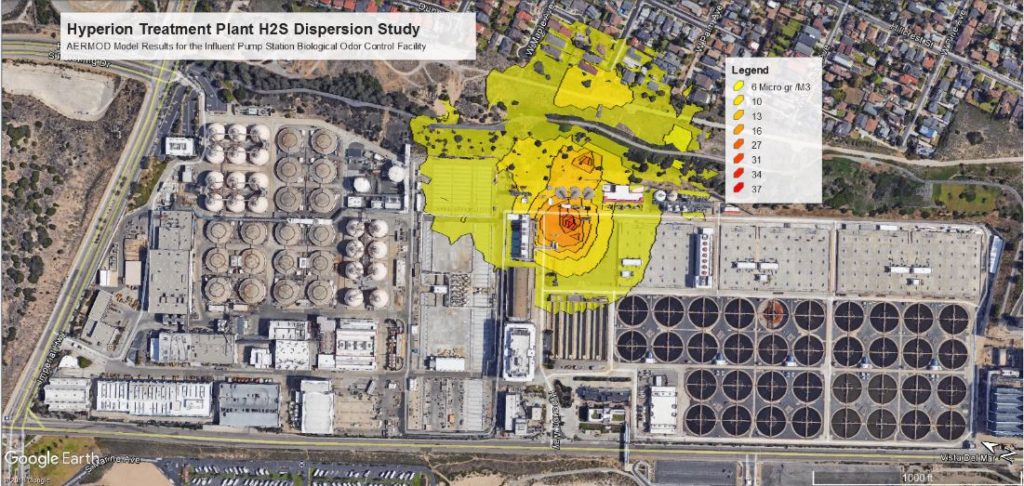
Courtyard by Marriott , Monterey Park, California: Hydrologic Routing Analysis of the Stormwater Detention Facility
The Atlantic Gateway Courtyard by Marriott in Monterey Park is a six-story, 288-room, 210,390-square foot hotel with ancillary retail space and two subterranean parking levels situated on a 2.14-acre site. The Stormwater management system for this site is based on a biofiltration system located above ground, thus requiring pumping. In addition, the computed 85th percentile rain runoff hydrograph has a peak rate that exceeds the treatment capacity of the biofilter, which means that the system requires storage. The system design directs all runoff captured at catch basins on ground level to a detention tank located in the basement where it gets pumped to the biofilter for treatment and release. SEITec conducted a technical review of the initial design and determined the optimum size of the pump(s) and the required storage capacity of the stormwater detention tank by using hydrologic (storage) routing of the 85th percentile rain runoff hydrograph. SEITec's analysis showed that the system only required 5000 gal of storage instead of the original 72,000 gal, and demonstrated satisfactory operation of the stormwater detention and treatment system to comply with regulatory requirements.
Project information
Location: Monterey Park, California, Client: Ethan Capitol, LLC, Status: Completed
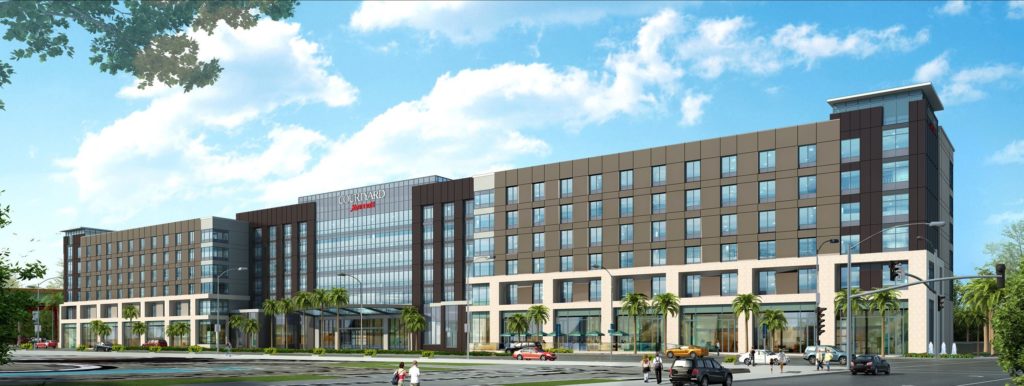 ;
;
Marina del Rey Enhanced Watershed Management Plan
The purpose of this work was to identify regional projects to maximize the capture and infiltration/reuse of stormwater from the 85th percentile, 24-hour storm event in Area1 of the Marina del Rey watershed. Work included study and hydrology/hydraulic analysis of (MdR) watershed, identification and analysis of stormwater BMPs, and recommendation on preferred strategy for regional projects in MdR. SEITec proposed a combination of the WaterSilo Cistern and infiltration system, which has a small foot print that fits the congested urban setting. The 1.0MG stormwater storage system provides 14.0 MG/YR of stormwater infiltration. The study provided a multi-benefit solution for water quality improvement and stormwater capture/reuse, distributed low impact solution in a congested urban area, and eliminated requirement for land acquisition.
Project information
Location: Marina del Rey, California, Client: City of Los Angeles, Bureau of Sanitation, Status: Completed

Sixth Street Viaduct Replacement – Bicycle & Pedestrian Facilities Connection Project
The City of Los Angeles is replacing the old Sixth Street Viaduct over the Los Angeles River and US Highway 101. At the same time, The City was awarded an Active Transportation Program (ATP) grant for a Bicycle and Pedestrian Facilities Connection Project, which will connect the Sixth Street Viaducts pedestrian trails to the Seventh Street sidewalks. The Bureau of Engineering (BOE) requested that SEITec be included in the design team because of our experience working with the City on a number of stormwater management projects that emphasize “storage and use” rather than “infiltration”. This is reflective of the City’s change in strategy, which is currently in the process of changing the Best Management Practices (BMP) hierarchy of priorities to “capture and use” first, followed by “infiltration”. SEITec will be responsible for developing a holistic stormwater management scheme that includes the drainage system and preferred BMPs for all seven ATP projects, including the East Park. Scope of work includes: 1) Review relevant records and documents, 2) Conduct site visit, 3) Develop holistic stormwater drainage and BMP system configuration, 4) Perform hydrology and hydraulic calculations to size the system components, 5) Workshop: “Stormwater Drainage and BMP System”, 6) Finalize the system configuration, 7) Prepare plans, specifications, and cost estimate (PS&E).
Project information
Location: Los Angeles, California, Client: City of Los Angeles, Bureau of Engineering, Status: Ongoing
